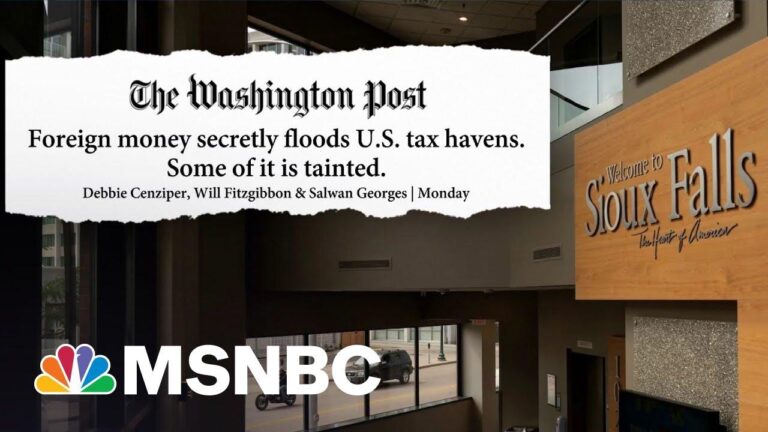Rising Tide of Foreign Capital in U.S. Tax Havens: Unveiling Risks and Regulatory Challenges
Escalating Foreign Investments Expose Weaknesses in U.S. Tax Haven Oversight
The recent influx of international capital into American tax haven jurisdictions has highlighted critical shortcomings in existing regulatory systems that were once deemed effective. These funds often navigate through intricate financial networks, complicating efforts by authorities to identify their true origins or detect illicit conduct promptly. Primary obstacles include:
- Permissive disclosure rules that allow for anonymous ownership structures
- Poor coordination among various financial regulatory bodies
- Limited funding and manpower dedicated to monitoring cross-border capital movements
This covert flow of foreign assets not only undermines the credibility of the U.S. financial infrastructure but also poses significant threats to national security and economic resilience. Investigations have uncovered complex webs of transactions involving shell corporations and offshore accounts, frequently linked to sanctioned individuals or corrupt foreign officials. The table below illustrates recent trends in foreign capital inflows associated with U.S. tax haven activities:
| Region of Origin | Approximate Annual Inflow (Billion $) | Percentage of Suspicious Transactions |
|---|---|---|
| Eastern Europe | 13.2 | 19% |
| Middle East | 10.4 | 24% |
| Asia-Pacific | 16.1 | 14% |
| Latin America | 7.8 | 17% |
Decoding the Origins of Questionable Funds Entering U.S. Tax Shelters
Investigative reports have brought to light a growing volume of foreign capital quietly entering U.S. tax shelters, with a notable share suspected to be linked to illicit activities. These financial flows are often masked by sophisticated ownership arrangements designed to hide the true beneficiaries. Particularly, entities from regions with high corruption indices and illicit trade activities exploit regulatory loopholes, enabling suspicious funds to blend seamlessly into the U.S. financial ecosystem.
Common features of these dubious capital movements include:
- Multi-layered shell corporations that obscure actual ownership
- Swift fund transfers across numerous accounts to avoid detection
- Investment in real estate and high-end assets as methods for laundering money
- Weak enforcement in certain jurisdictions facilitating these operations
These trends underscore the pressing need for enhanced financial transparency and international collaboration. The table below compares how various asset types are exploited for these purposes:
| Asset Category | Share of Illicit Funds (%) | Typical Application |
|---|---|---|
| Real Estate | 47% | Concealing wealth and capital appreciation |
| Luxury Items | 23% | Storing value and facilitating resale |
| Financial Products | 18% | Complex investment vehicles |
| Cryptocurrency | 12% | Anonymous and rapid transfers |
Consequences of Hidden Foreign Investments on U.S. Financial Stability
The growing volume of undisclosed foreign capital funneled into U.S. tax havens is triggering alarm over the nation’s financial transparency and regulatory effectiveness. These investments, often channeled through elaborate corporate entities, mask the true ownership and source of funds, facilitating the mingling of illicit money with legitimate economic activities. Regulatory bodies are increasingly challenged to track these covert investments, which erode the trustworthiness of the U.S. financial system and expose it to risks such as money laundering, tax fraud, and threats to national security. Contributing factors include:
- Gaps in corporate registration laws that permit anonymous ownership
- Inadequate vetting of high-risk foreign investors
- Disjointed communication among enforcement agencies
The following table highlights key categories of suspicious foreign investments identified in the last fiscal year, along with their associated risks:
| Investment Category | Estimated Volume (Billion $) | Associated Risk |
|---|---|---|
| Anonymous Limited Liability Companies (LLCs) | 13.1 | Hidden ownership, laundering activities |
| Shell Corporations | 10.0 | Tax avoidance, illicit financing |
| Real Estate Investment Trusts (REITs) | 8.2 | Asset concealment, capital flight |
Strategic Policy Interventions to Boost Transparency and Accountability
To counteract the rising tide of foreign capital infiltrating U.S. tax havens, policymakers must enact comprehensive reforms that enhance visibility into financial flows and enforce accountability. A holistic strategy is vital, including rigorous beneficial ownership disclosure mandates to ensure that the true proprietors behind shell companies and trusts are publicly identifiable. Without such transparency, these financial sanctuaries will continue to attract illicit funds, eroding confidence in the financial system.
Furthermore, bolstering interagency collaboration and increasing funding for financial intelligence units will improve enforcement effectiveness. Recommended policy actions encompass:
- Compulsory reporting: Implement real-time disclosure of transactions involving high-risk countries
- Enhanced due diligence: Mandate financial institutions to apply stringent client verification procedures
- Global cooperation: Promote information sharing and joint efforts with international regulators and law enforcement agencies
| Policy Focus | Existing Challenge | Recommended Solution |
|---|---|---|
| Beneficial Ownership Transparency | Opaque corporate structures conceal true owners | Establish mandatory public ownership registries |
| Transaction Surveillance | Delayed or absent reporting mechanisms | Deploy real-time transaction monitoring systems |
| International Collaboration | Fragmented and inconsistent information exchange | Create unified global regulatory frameworks |
Final Thoughts
As ongoing investigations continue to unravel the intricate networks channeling foreign capital into U.S. tax havens, critical questions remain about the legitimacy and provenance of these funds. While the economic impact of this discreet influx is substantial, the potential entanglement with illegal activities presents urgent challenges for regulators and policymakers. Addressing these issues demands enhanced transparency, stronger enforcement mechanisms, and robust international cooperation to safeguard the integrity of the American financial system. The narrative of foreign wealth quietly permeating U.S. tax shelters is evolving, and its implications for national security and economic stability warrant vigilant attention in the coming years.







